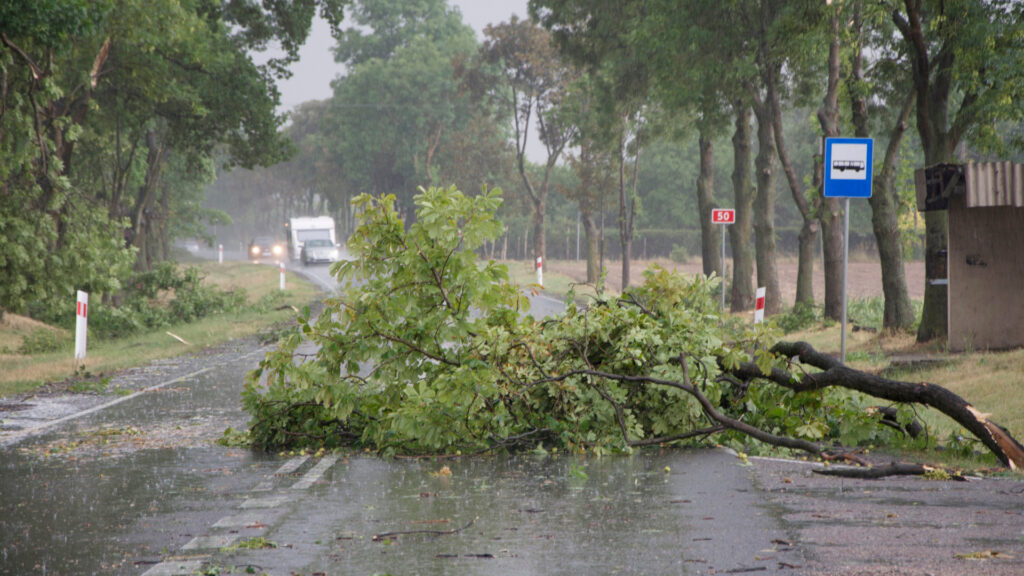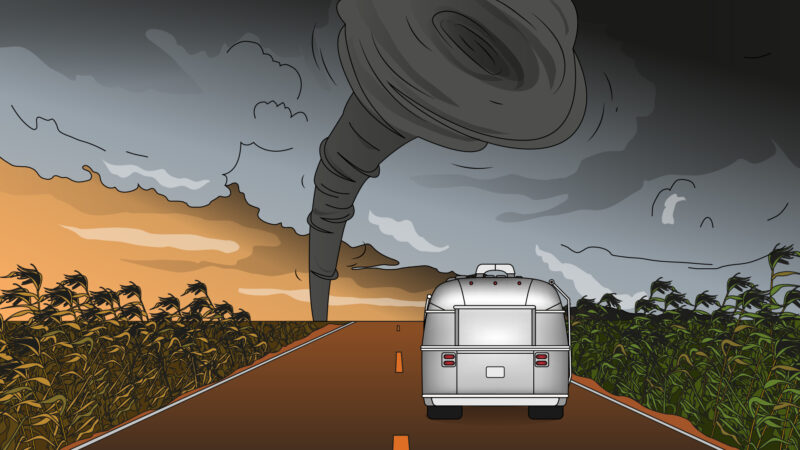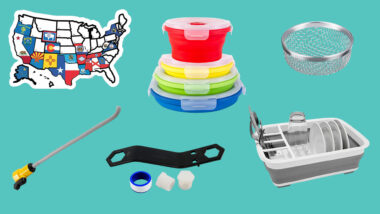Table of Contents Show
Driving an RV can be a bit intimidating in ideal weather conditions. However, when you add sustained winds or excessive wind gusts, the situation can quickly turn dangerous. Today we want to look at if it’s safe to drive your RV when it’s windy. We also want to provide you with a handful of tips for those windy days. Let’s get started!
Is It Safe to Drive Your RV When It’s Windy?
Driving in windy conditions can be dangerous, but there are many variables to consider. If you tow a long or tall RV, it becomes a massive wind block. Wind gusts can catch you off guard and cause you to lose control or hit something or someone else.
You must know your limitations when it comes to driving your RV in windy conditions. If you don’t have much experience towing, you might feel the need to pull over sooner than a more experienced driver. The more you drive, the more comfortable you may feel when your trailer begins to sway.
When in doubt, find a safe place to pull over to make a plan. It’s not worth putting yourself or other drivers in danger.
How Windy Is Too Windy to Drive an RV?
Depending on the size of your RV and your setup, you may not notice winds under 20 mph. This also depends on how fast you drive and the direction the wind is blowing against your RV.
When deciding how windy is too windy to drive an RV, you need to know your limits. If you struggle to keep your RV in your lane, it’s a good sign that you need to find a safe spot to pull over until the winds die down.
Winds of 60 mph can tip fully-loaded semis. Semis weigh much more than an RV, and so if you see them pulling over due to the conditions, you should do the same.
You should also be mindful of any signs alerting you of unsafe road conditions. Some locations will experience sandstorms in high winds. This can cause visibility issues so bad that you can’t see the road in front of you. You will likely do fine if you stay alert, keep safety in mind, and know your abilities.

Can Wind Tip-Over an RV on the Road?
RVs, semis, and other large loads can easily tip over in high wind conditions. Even winds reaching 60 mph can tip your rig. This causes an unsafe situation for you, your passengers, and other drivers.
What Are Wind Restrictions for Drivers?
You may encounter roads that have wind restrictions for drivers. These typically vary from location to location and depend on a multitude of factors. Areas with high winds will likely have warning signs to alert drivers, but they may also close the roads due to the weather.
Large bridges and valleys commonly face wind restrictions. Keep an eye on the weather if you plan on traveling through areas known for wind closures. This may require you to stay put or, if possible, find an alternate route.
Tips for Driving Your RV on Windy Days
Weather changes constantly, and even though you didn’t plan to drive your RV in the wind, it will likely happen eventually. When that day comes, you must keep a few things in mind. Let’s take a look at a handful of tips for driving an RV on windy days.
Take It Slow
The words “fast” and “RV” typically never go together. When you drive a massive RV down the road, the best rule of thumb is slow and steady wins the race. This is especially important in high winds — slow is good.
By taking your foot off the pedal and reducing your speed, you allow yourself to maintain control of the RV. The faster you travel, the more you’ll feel the effects of the wind. It can push you around the road. If you can’t travel at a safe speed, pull over until the weather conditions improve.

Only Travel If You Must
When wind speeds become excessive, you should evaluate your needs. If you must travel, you may need to put in a little more effort to get to your destination. However, if the winds pick up and it’s not a necessity for you to travel, then don’t.
Check with the campground or hosts and see if you can extend your stay or get a late checkout to wait out the weather. Your safety is important to them too. You may have to pay for another night or move to a different site. However, your well-being is more important than a few bucks or the inconvenience of moving across the campground.
If You Feel Unsafe, Stop
The great thing about RVs is that you travel with your home. If you find yourself in dangerous conditions, you should look for a safe place to pull over or stop for the night until the weather improves. You may find a rest stop, travel plaza, or even a big-box retailer. Plus, you can take the chance to restock on snacks or other essentials you might need.
Always Check The Weather
If you can stay connected, keep an eye on the weather for your travel days as they approach. This can help you know what to expect and give you time to develop a backup plan. By checking the weather, you can shift things around. You may leave earlier or stay later at your current spot to avoid any nasty wind.
Pro Tip: Check road conditions in every state via the National Weather Service’s website.
Fill Your Tanks With Water
If you’ve got room to spare in your carrying capacity, filling your tanks is a great way to increase the weight of your RV. This helps lessen the impact the wind has on your RV as you travel.
Plus, you’ll likely use the water eventually. You can get a step ahead of the game for your next boondocking or dry camping adventure. Or you can use the water at your next spot to avoid wasting it. However, if you plan to put your RV in storage, open your fresh tank release valve to allow the water to drain before putting it in storage.
Watch for Wind Restrictions
Know your route ahead of time and watch for any signs of wind restrictions in the area. Many locations with wind closures like bridges and busy roads will have websites or social media pages.
They’ll typically send alerts regarding closures to help keep travelers informed. Look at the past several days to predict whether the route will have restrictions during your travels.
It’s also important to consider when you travel. These wind restrictions typically occur during a given season. This means you can avoid windy conditions during different times of the year.

Avoid Driving in Windy Conditions if Possible
Driving in windy conditions is not enjoyable for anyone on the road, especially when driving an RV. You should never put yourself or other drivers in an unsafe situation. If you can avoid driving in windy conditions, do it.
If not, follow all signage regarding travel restrictions, follow our tips, and drive as slow and safe as possible. Have you ever had to change your RV travel plans due to high winds?






